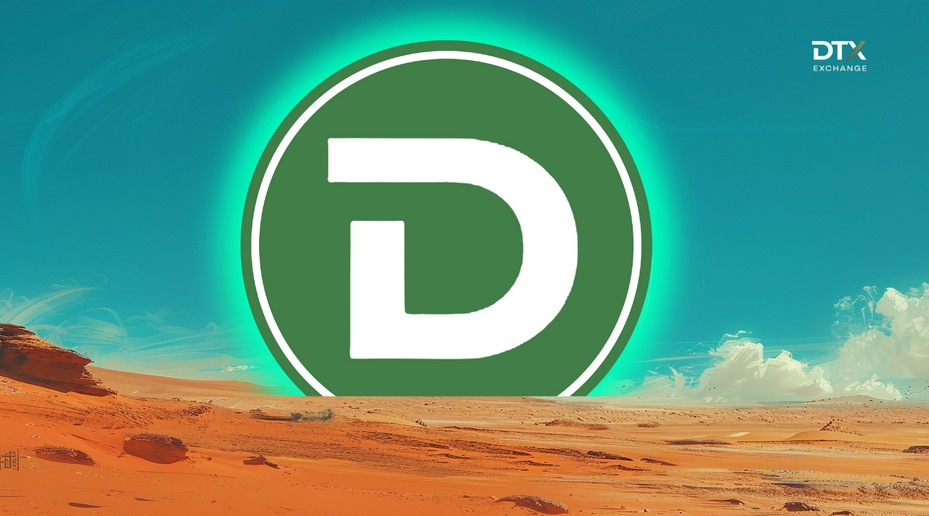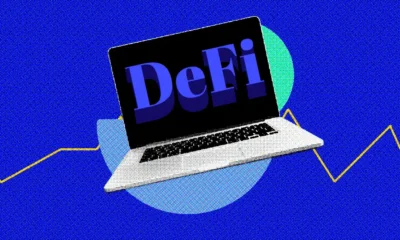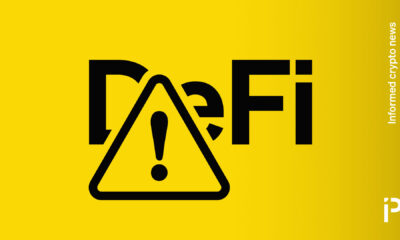DeFi
The changing face of risk in DeFi

Decentralized finance (DeFi) is experiencing new momentum. Activity in new ecosystems and high returns resemble the famous DeFi Summer 2021. The variety of innovative protocols makes it incredibly difficult for investors to keep up, while at the same time the impressive growth raises concerns about risks that are accumulating in the DeFi ecosystem.
You may have heard the doomsday analyzes comparing the most successful protocols of this wave, like Ethena or the Eigen Layer LRT, with risk management disasters like Terra, without really providing credible evidence of the parallels. The fact is that this new generation of fast-growing DeFi protocols is much more mature and a lot of thought has gone into risk management. However, there are still many risks.
Jesus Rodriguez, CEO of IntoTheBlock, is a speaker on the AI Stage at Consensus 2024from May 29 to 31.
The biggest risk in today’s DeFi market lies not in mechanical failures like those that caused Terra to collapse, but rather in three key factors: scale, complexity, and interconnectivity.
The protocols in this DeFi wave have become quite large in a matter of months, they enable more complex financial primitives, and they are incredibly interconnected. This combination of complexity, size, and interconnectivity has significantly exceeded the capabilities of risk models in today’s DeFi market. Simply put, there are many risk conditions in today’s DeFi markets for which we do not have credible risk models. And this gap seems to be growing instead of narrowing.
Risk has been part of the DeFi narrative since the beginning, and it is very easy to discuss in broad, generic terms. This new era of DeFi brings new innovations and has grown considerably quickly. As a result, risk takes on a different connotation than before. Taking a first-principles approach to analyzing risk in the DeFi era highlights four fundamental factors: scale, speed, complexity, and interconnectivity.
To illustrate these factors, consider the differences in risk quantification for a basic AMM with a few hundred million TVL versus an AMM that uses reinvested assets with their corresponding points systems and introduces its own tokens and points. The first risk model can be solved with basic statistical or machine learning methods. The latter enters the realm of much more advanced branches of mathematics and economics such as complexity or chaos theory, which are far from being applied in DeFi.
Let’s look at the different factors in more detail.
The story continues
1) Scale
The principle of the relationship between risk and scale in DeFi is incredibly simple. In financial markets, modeling risk at a smaller scale, say a few hundred million, is very different from modeling risk at a few hundred billion. On a larger scale, risk conditions still appear that were not present on a smaller scale. This principle certainly applies to DeFi as a parallel financial system with many interconnected primitives.
Ethena is one of the most innovative projects in the current wave of DeFi and has attracted billions of TVL in just a few months. The biggest challenge for Ethena in today’s market is adapting its risk and insurance models to this scale in the event of negative financing rates for a long period of time.
2) Speed
The relationship between risk and speed is the traditional friction between growing too much and too fast. As a condition of risk, speed acts as an accelerator of evolution. A protocol that scales from a few million to a few billion TVL in just a few months may not have time to adjust its risk models to the new scale before unforeseen risk conditions arise.
The rapid rise of Clean diaper sparked a whole movement of LRTs, many of which reached several billion TVL in just a few months while still lacking basic features like withdrawals. The combination of speed and scale can exacerbate simple disaggregating conditions into truly impactful risk factors in some of these protocols.
3) Complexity
The entire field of complexity theory was born to study systems that escape the laws of predictive models. Economic risk has been at the center of complexity theory almost since its beginnings, as global economies rapidly outpaced risk models after World War II. Modeling risk in a simple economic system is simply simple.
In the new wave of DeFi, we have protocols such as Pendle or Gearbox, which abstract away quite sophisticated primitives such as yield derivatives and leverage. The risk models for these protocols are fundamentally more difficult than those of the previous generation of DeFi protocols.
4) Interconnectivity
Widely interconnected economic systems can be a nightmare from a risk perspective, as any situation can have many cascading effects. However, interconnectivity constitutes a natural step in the evolution of economic systems.
The current DeFi ecosystem is much more interconnected than its predecessors. We have takeover derivatives in EigenLayer that are tokenized and traded in pools in Pendle or used with leverage in Gearbox. The result is that risk conditions within a protocol can quickly seep into different key building blocks of the DeFi ecosystem, making risk models incredibly difficult to construct.
Hacks and exploits have been the dominant risk theme in DeFi in recent years, but that could start to change. The new generation of DeFi protocols is not only more innovative but also much more robust from a technical security point of view. Auditing firms have become smarter and protocols take security much more seriously.
As an evolving financial system, the risk of DeFi appears to be shifting from technical to economic. Rapid, large-scale growth speed, increasing complexity, and deep interconnectivity are moving DeFi into unforeseen territories from a risk perspective. With only a handful of companies working on risk in DeFi, the challenge now is to catch up.
DeFi
Cryptocurrency and defi firms lost $266 million to hackers in July

In July 2024, the cryptocurrency industry suffered a series of devastating attacks, resulting in losses amounting to approximately $266 million.
Blockchain Research Firm Peck Shield revealed in an X post On August 1, attacks on decentralized protocols in July reached $266 million, a 51% increase from $176 million reported in June.
The most significant breach last month involved WazirX, one of India’s largest cryptocurrency exchanges, which lost $230 million in what appears to be a highly sophisticated attack by North Korean hackers. The attack was a major blow to the stock market, leading to a break in withdrawals. Subsequently, WazirX launched a program in order to recover the funds.
Another notable incident involved Compound Finance, a decentralized lending protocol, which suffered a governance attack by a group known as the “Golden Boys,” who passed a proposal who allocated 499,000 COMP tokens – valued at $24 million – to a vault under their control.
The cross-chain liquidity aggregation protocol LI.FI also fell victim On July 16, a hack resulted in losses of $9.73 million. Additionally, Bittensor, a decentralized machine learning network, was one of the first protocols to suffer an exploit last month, loming $8 million on July 3 due to an attack targeting its staking mechanism.
Meanwhile, Rho Markets, a lending protocol, suffered a $7.6 million breach. However, in an interesting twist, the exploiters research to return the stolen funds, claiming the incident was not a hack.
July 31, reports The Terra blockchain protocol was also hacked, resulting in a loss of $6.8 million across multiple cryptocurrencies. As crypto.news reported, the attack exploited a reentrancy vulnerability that had been identified a few months ago.
Dough Finance, a liquidity protocol, lost $1.8 million in Ethereum (ETH) and USD Coin (USDC) to a flash loan attack on July 12. Similarly, Minterest, a lending and borrowing protocol, saw a loss of $1.4 million due to exchange rate manipulation in one of its markets.
Decentralized staking platform MonoSwap also reported a loss of $1.3 million following an attack that allowed the perpetrators to withdraw the liquidity staked on the protocol. Finally, Delta Prime, another decentralized finance platform, suffered a $1 million breach, although $900,000 of the stolen funds was later recovered.
DeFi
Centralized crypto exchanges are slowly losing ground to their DeFi counterparts

Centralized crypto exchanges are slowly losing ground to their DeFi counterparts, according to an in-depth data analysis conducted by Decrypt.
DeFiLlama’s decentralized exchange (DEX) volume data and CoinGecko’s total cryptocurrency trading volume data show that the percentage of cryptocurrency trading volume occurring on DEXs relative to total trading volume has increased from 4.6% in February to over 7% this month. This is an increase in the share of trading volume driven by DEXs of over 52%.
Source: Adrian Zmudzinski
Kunal Goel, a senior research analyst at Messari, told Decrypt that several factors are fueling the growth in DEX market share. He cited “the growth of meme coins and long-tail assets” as one of the reasons, explaining that they tend to list first on DEXs and only appear on centralized exchanges much later.if they last that long.
“The onchain user experience has improved with low fees and high throughput on Solana and Ethereum L2,” he added, highlighting advancements making decentralized finance (DeFi) solutions increasingly easier to use.
DeFiLlama data further shows that over the past 24 hours, DEX volume accounted for 22% of total trading volume. The crypto price aggregator notes that this percentage is meant to represent the dominance of decentralized exchanges over aggregated decentralized exchanges and centralized exchanges.
So far in 2024, DEX volume has seen a slow and steady increase.
CEX and DEX trading volume increased from $133.5 billion in January to $179.5 billion this month, an increase of about 34%. The year-to-date high was recorded in March, when CEX and DEX volumes saw a sharp increase, reaching $4.8 trillion and $266.89 billion, respectively.
Goel noted that at the time, “Bitcoin hit new all-time highs in March and trading activity is generally positively correlated with price and sentiment.” Looking ahead, he expects centralized exchanges to move on-chain and disrupt their own business models before others can. He added that “Base and BNB Chain are the most prominent examples of this.”
TradingView also shows a DeFi market cap dominance chart, in percentage terms. Currently at 3.86%, it fell from 4.47% on January 1 and hit a 2024 high of 4.81% on February 25. Goel noted that this was unexpected since “DEX volumes are a key driver of DEX value, so it’s a bit contradictory.”
Challenge is an umbrella term for a group of financial tools built on a blockchain, including DEXs, exchanges that operate primarily on-chain. The primary goal of DeFi is to allow anyone with internet access to lend, borrow, and bank without relying on intermediaries.
Similarly, the main goal of DEXs is to allow anyone with internet access to trade or even provide liquidity in exchange for a stake. DeFi and DEXs are one of the main areas of focus in decentralized application (dapp) development, which have seen considerable adoption this year.
Edited by Stacy Elliott.
DeFi
Pump.Fun Overtakes Ethereum in Daily Revenue: A New Leader in DeFi

In a remarkable turn of events, Pump.Fun, a memecoin launchpad, has surpassed all other platforms in the decentralized finance (DeFi) sector, achieving the highest gross revenue in the last 24 hours. According to data from DeFiLlama, Pump.Fun amassed $867,429 during this period, surpassing Ethereum’s $844,276. This achievement underscores the growing influence of memecoin infrastructure within DeFi.
Pump.Fun Revenue Milestones
The impressive revenue numbers go beyond daily performance. Pump.Fun is generating $315 million in annualized revenue, averaging $906,160 per day over the past week. This revenue surge is largely due to the recent memecoin frenzy, with Solana-based memecoins being particularly popular among on-chain enthusiasts. The platform’s user-friendly interface allows non-technical users to quickly launch their own tokens, spending as little as $2 without needing to provide any initial liquidity.
How Pump.Fun works
Pump.Fun’s operating model is designed to facilitate the use and rapid launch of tokens. Users can create new tokens in minutes, which are then allowed to trade along a bonding curve until they reach a market cap of approximately $75,000. At this point, the bonding curve is burned on Raydium, establishing a secure liquidity pool. The platform generates revenue through a 1% fee on transactions made on the platform. However, once a token is bonded and burned on Raydium, Pump.Fun stops charging this fee.
Ethereum: Traditional Power
Despite its daily revenues, Ethereum remains a cornerstone of the DeFi ecosystem. It is the blockchain of Ether, the second-largest cryptocurrency with a market cap of $395 billion. Ethereum powers many applications and digital assets, backing over $60 billion worth of smart contracts. Revenue generation on Ethereum is done through transaction fees, called gas, which are paid in ETH for executing transactions and smart contracts.
Comparative analysis of revenue models
While Ethereum’s revenue model relies on gas fees for transactions and smart contract executions, Pump.Fun takes a different approach. By enabling easy and low-cost token launches, Pump.Fun caters to a broad audience, including non-technical users. This inclusiveness, combined with the excitement surrounding memecoins, has led to rapid revenue growth. The 1% transaction fee ensures continued revenue generation until the token transitions to Raydium, creating a sustainable business model.
Memecoin frenzy
The recent rise in popularity of memecoins has been a major contributor to Pump.Fun’s success. Memecoins, particularly those based on Solana, have captivated the DeFi community, generating substantial activity on platforms like Pump.Fun. This trend highlights a shift in DeFi dynamics, where niche platforms catering to specific interests can achieve significant revenue milestones.
Future prospects
Pump.Fun’s recent successes suggest a potential shift in the DeFi landscape. As the platform continues to attract users with its simple token launch process and low-cost entry point, it could solidify its position as a leader in the DeFi space. The memecoin phenomenon shows no signs of slowing down, indicating that platforms like Pump.Fun could continue to see robust growth.
In conclusion, Pump.Fun’s ability to surpass Ethereum in terms of daily revenue underscores the evolving nature of the DeFi space. By providing a user-friendly platform for launching memecoins, Pump.Fun has tapped into a lucrative niche, demonstrating the potential for niche platforms to thrive alongside traditional blockchain giants like Ethereum. This development signals a broader trend toward diversification and innovation within the DeFi ecosystem, with new entrants challenging established players through unique value propositions and targeted services.
DeFi
$10 Billion Venture Firm May Target 10x Opportunities in Ripple (XRP) and This DeFi Token

According to recent reports, one of the largest venture capital firms is looking for new opportunities in the cryptocurrency space as Bitcoin (BTC) attempts to break its all-time high and start a new bull run in the cryptocurrency market. They are balancing risk with low-risk, low-reward and high-risk, high-reward opportunities.
The first investment candidate is a top cryptocurrency, Ripple (XRP); it doesn’t have much growth potential because it’s already a large cap. Another scenario the firm is targeting is DTX ExchangeThe new hybrid exchange is expected to revolutionize the foreign exchange industry. According to analysts, its growth potential is immense and the risk is also very limited due to its low price.
Market is bullish as Trump wants to make US a Bitcoin (BTC) superpower
Over the past 30 days, Bitcoin (BTC) has increased by about 10%, and one of the catalysts for this price increase has been Donald Trump recently speaking out as a crypto pro. Presidential candidate Donald Trump has promised to make the United States the world leader in cryptocurrencies if elected in November. Speaking at the Bitcoin2024 conference in Nashville, Trump compared Bitcoin (BTC) to the steel industry of 100 years ago, highlighting its potential.
Trump’s plans include firing SEC Chairman Gary Gensler and immediately creating a “Presidential Advisory Council on Bitcoin (BTC) and Cryptocurrencies.” He stressed the importance of American leadership in the cryptocurrency space, saying, “I am laying out my plan to ensure that the United States is the cryptocurrency capital of the planet and the Bitcoin (BTC) superpower of the world.”
$600 Million Worth of Ripple (XRP) to Be Released in August
Ripple (XRP), the company behind the XRP Ledger blockchain and its native token Ripple (XRP), unlocks up to 1 billion tokens on the first day of every month. Since 2017, they have used several major escrow wallets, including Ripple (XRP) (24) and Ripple (XRP) (25), to evenly distribute these monthly unlocks.
However, Ripple (XRP) often relocks a large portion of newly issued XRP. For example, on June 1, Ripple (XRP) relocked 800 million XRP but still sold about 300 million XRP, worth $182 million at the time.
While Ripple (XRP) releases up to 1 billion XRP tokens each month, the actual amount released into circulation is typically much lower due to this re-escrow process, as noted in a 2017 XRP Ledger blog post.
DTX Exchange Follows Bitcoin (BTC) Path
The main target of large private equity firms is the DTX exchange (DTX), the reason being a clearly high utility like Bitcoin (BTC). This project has attracted global attention thanks to its exceptional pre-sale performance, offering early buyers a 100% return on investment and raising over $1 million. Projections suggest that this figure will reach $2 million by the end of August 2024.
DTX Exchange offers a revolutionary hybrid trading platform, combining the best features of centralized (CEX) and decentralized (DEX) exchanges. Traders can enjoy a seamless experience with access to over 120,000 asset classes, no KYC verification upon registration and ultra-fast transaction speeds of 0.04 seconds.
These benefits have attracted traders to this new cryptocurrency exchange. Currently, in Phase 2 of its pre-sale, DTX Exchange is listed at $0.04, which is double its starting price of $0.02. Market analysts predict that the upcoming listing of DTX Exchange on the Level 1 CEX in late 2024 could trigger a 100x bullish rally, making DTX Exchange the top cryptocurrency exchange to watch.
Learn more:
Disclaimer: The statements, views and opinions expressed in this article are solely those of the content provider and do not necessarily represent those of Crypto Reporter. Crypto Reporter is not responsible for the reliability, quality and accuracy of the materials contained in this article. This article is provided for educational purposes only. Crypto Reporter is not responsible or liable, directly or indirectly, for any damage or loss caused or alleged to be caused by or in connection with the use of or reliance on any content, goods or services mentioned in this article. Do your research and invest at your own risk.
-

 Videos9 months ago
Videos9 months agoCrypto News: Bitcoin, ETH Price, CPI Print, PYTH, WIF & MORE!!
-

 Videos9 months ago
Videos9 months agoCrypto News: Bitcoin Price, ETF, ETH, WIF, HNT & MORE!!
-

 DeFi9 months ago
DeFi9 months agoMetasphere Labs announces follow-up event regarding
-

 Videos9 months ago
Videos9 months agoSolana price potential?! Check out THIS update if you own SOL!!
-

 Videos8 months ago
Videos8 months agoWho Really CONTROLS THE MARKETS!! Her plans REVEALED!!
-

 DeFi6 months ago
DeFi6 months agoPump.Fun Overtakes Ethereum in Daily Revenue: A New Leader in DeFi
-

 DeFi6 months ago
DeFi6 months agoDegens Can Now Create Memecoins From Tweets
-

 News6 months ago
News6 months agoNew bill pushes Department of Veterans Affairs to examine how blockchain can improve its work
-

 News6 months ago
News6 months agoLawmakers, regulators to study impact of blockchain and cryptocurrency in Alabama • Alabama Reflector
-

 Bitcoin6 months ago
Bitcoin6 months ago1 Top Cryptocurrency That Could Surge Over 4,300%, According to This Wall Street Firm
-

 Ethereum8 months ago
Ethereum8 months agoComment deux frères auraient dérobé 25 millions de dollars lors d’un braquage d’Ethereum de 12 secondes • The Register
-

 Videos8 months ago
Videos8 months agoCryptocurrency News: BTC Rally, ETH, SOL, FTM, USDT Recover & MORE!

















